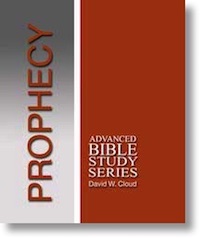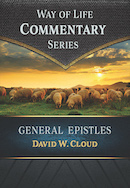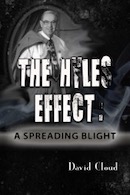866-295-4143, fbns@wayoflife.org
This book is out or print and superseded by the new Course book. Click the link above.

In the Bible, figurative language is used for the same purposes as in ordinary speech and it is interpreted by the same rules, but it is used for other purposes, as well.
It is important to understand that figurative language is a major element of the Hebrew mindset. It is not mere poetry. It is not just “flowery language” that we can take or leave, as is often the case in other literature. The figurative language is a fundamental part of God’s revelation, and the Jews were taught to think like this by their very language and by being weaned on Scripture. God not only taught the nation Israel what to think, but also how to think.
“A pre-existing type of thinking was given to the Hebrew people, along with their language. This thinking was designed by God as the perfect medium for His revelation of Himself to mankind. This thinking related the world together and saw its totality within God, interconnected with His Person as its Creator. The entire world is His creation, and His revelation. The Hebrews thought in intrinsic associations or likenesses. Combined with the proper understanding of the world’s relationship to its Creator, they could ‘see’ or ‘visualize’ the intrinsic connections between the physical world and the eternal, invisible world. They understood that the creation was not God but that God was completely manifest in it and could be likened to every part of it” (Jonathan Cloud, “Some Thoughts on Faithful Ancient Hebrew Thinking,” Aug. 2, 2017).
One of the purposes of the creation is revelation, to teach men about God and about life itself (Ps. 19:1-3; Ro. 1:20), and Scripture is filled with lessons from creation, particularly by means of parables, similes, metaphors, and personification. In Hosea alone we find the following examples: lion (Hos. 5:14); dove (Ho. 7:11); eagle (Ho. 8:1); wind (Hos. 8:7); grape (Hos. 9:10); fig tree (Ho. 9:10); bird (Ho. 9:11); root (Ho. 9;15); fruit (Ho. 9:16); empty vine (Ho. 10:1); foam on water (Ho. 10:7); heifer (Ho. 10:11).
The Bible writers made use of every aspect of creation to illustrate spiritual truths.
Following are some of the types of figurative speech in Scripture:
Simile (similitude): Comparing two things using adverbs such as “like” and “as”
“The moon became as blood” (Re. 6:12)
“The shall be like a tree planted by the rivers of water” (Ps. 1:3)
“Ye are as sheep going astray” (1 Pe. 2:25).
In Revelation 1:12-16 we have a description of Christ, and some of it is simile, as we see by the use of adverbs -- “like wool” (v. 14), “white as snow” (v. 14), “as a flame of fire” (v. 14), “like unto fine brass” (v. 15), “as the sound of many waters” (v. 15), “as the sun shineth in his strength” (v. 16).
The book of Proverbs is filled with simile. “But the path of the just is as the shining light, that shineth more and more unto the perfect day” (Pr 4:18). “As vinegar to the teeth, and as smoke to the eyes, so is the sluggard to them that send him” (Pr. 10:26). “Confidence in an unfaithful man in time of trouble is like a broken tooth, and a foot out of joint” (Pr 25:19).
Metaphor: A comparison without the use of the adverbs
“All flesh is as grass” (1 Pe. 1:24) is a simile, and “all flesh is grass” (Isa. 40:6) is a metaphor.
“Jehovah is my rock, fortress, buckler, horn, high tower” (Ps. 18:2).
“the windows of heaven” (Mal. 3:10)
“Ye are the salt of the earth” (Mt. 5:13)
“This is my body” (Mt. 26:26)
Christ is called a rock (1 Co. 10:4), a chief cornerstone (1 Pe. 2:6), a lion (Re. 5:5), a lamb (Joh. 1:29), a door (Joh. 10:7), a vine (Joh. 15:1), bread (Joh. 6:51), a foundation (1 Co. 3:11).
The book of Proverbs is filled with metaphors. “A continual dropping in a very rainy day and a contentious woman are alike” (Pr. 27:15).
Revelation 1 -- “like wool” (v. 14), “white as snow” (v. 14), “as a flame of fire” (v. 14), “like unto fine brass” (v. 15), “as the sound of many waters” (v. 15), “as the sun shineth in his strength” (v. 16).
Metonymy: “When one noun is substituted for another noun; when cause is substituted for effect; or, when something is substituted for attributes or attainments.” “A related thing stands for the thing itself.”
“crown” signifies the king and kingdom (La. 5:16)
“two nations are in thy womb” (Ge. 25:23)
“Jacob have I loved, but Esau have I hated” (Ro. 9:13) signifies their offspring
“throne” signifies kingship and kingdom (1 Ch. 17:12)
“ears” and “eyes” signify understanding (Isa. 6:10)
“mine eyes have seen thy salvation” (Lu. 2:29-30)
“this cup is the new testament in my blood” (Lu. 22:20)
“cup” signifies the drinking of the juice in the Lord’s Supper (1 Co. 11:26)
“Moses and the prophets” signify the Old Testament (Lu. 16:29)
“bearing the sword” signifies capital punishment (Ro. 13:4)
Synecdoche (si-nek-duh-kee): The part is put for the whole or the whole for the part
“then shall ye bring down my gray hairs with sorrow to the grave” (Ge. 42:38)
“clean hands” signifies righteous living (Ps. 24:4).
“tongue” signifies a lying person (Ps. 52:4)
“hand” refers to God’s actions (Ps. 109:27).
“hoary head” signifies old age (Pr. 16:31).
“wheels” signifies chariots (Is. 5:28)
“sword” signifies war (Isa. 51:19; Jer. 14:13).
“sword” and “bow” and “arrows” signify God’s judgment (Ps. 71:12-13).
“flesh and blood” signifies man (Mt. 16:17).
“Jacob” signifies and stands for Israel (Jer. 10:16).
“Ephraim” signifies northern Israel (Hos. 11:12).
“way of Cain,” “error of Balaam,” “gainsaying of Korah” (Jude 1:11) refer to the chief characteristic of these men.
Personification: Speaking of inanimate objects or things as if they were animate
“the hills shall break forth into singing, and all the trees of the field shall clap their hands” (Isa. 55:12)
“the earth opened her mouth” (Nu. 16:32)
“When Israel went out of Egypt ... the sea saw it, and fled ... the mountains skipped like rams” (Ps. 114:1-4)
“the land mourneth (Joe. 1:10)
“prophesy unto the mountains of Israel” (Eze. 36:1)
“the mountains saw thee, and they trembled” (Hab. 3:10)
“death” is addressed as an animate thing (1 Co. 15:55)
Hyperbole: An exaggeration used for emphasis
“the cities are great and walled up to heaven” (De. 1:28)
“every one could sling stones at a hair breadth, and not miss” (Jud. 20:16)
“If I forget thee, O Jerusalem, let my right hand forget her cunning” (Ps. 137:5)
“Oh that mine head were waters!” (Jer. 9:1)
“Tyrus ... heaped up silver as the dust” (Zec. 9:3)
“Yea, though he live a thousand years twice told, yet hath he seen no good: do not all go to one place?” (Ec 6:6)
“Ye mountains of Gilboa, let there be no dew, neither let there be rain, upon you, nor fields of offerings: for there the shield of the mighty is vilely cast away, the shield of Saul, as though he had not been anointed with oil” (2 Sa. 1:21).
“And if thy right eye offend thee, pluck it out, and cast it from thee: for it is profitable for thee that one of thy members should perish, and not that thy whole body should be cast into hell. (Mt. 5:29). This is hyperbole to emphasize the necessity of getting saved before it is too late and of not allowing anything to hinder getting saved.
Irony: A thought that is expressed in such a way that it has the opposite meaning
“No doubt but yet are the people, and wisdom shall die with you” (Job 12:2)
“Cry aloud: for he is a god; either he is talking, or he is pursuing, or he is in a journey, or peradventure he sleepeth, and must be awaked” (1 Ki. 18:27)
Parable or allegory: An extended simile
The king of Babylon is likened to a great eagle (Eze. 17:2-3).
Israel is likened to a vine (Ps. 80:8-13).
Symbol or type: A material object used to illustrate spiritual truth
Prime examples are the tabernacle and its articles (e.g., the gate into the court, the altar of sacrifice, the laver of washing, the candlestick, the table of shewbread, the incense altar, the mercy seat, the ark of the covenant).
Other examples are manna, the brazen serpent, and Jeremiah’s yokes (Jer. 27:1-8).
Anthropomorphism: Human features attributed to God
“For the eyes of the Lord are over the righteous, and his ears are open unto their prayers: but the face of the Lord is against them that do evil” (1 Pe. 3:12).
Paradox: A seeming contradiction
“troubled on every side, yet not distressed” (2 Co. 4:8)
“perplexed, but not in despair” (2 Co. 4:8)
“persecuted, but not forsaken” (2 Co. 4:8)
“persecuted, but not forsaken” (2 Co. 4:9)
“cast down, but not destroyed” (2 Co. 4:9)
“as sorrowful, yet alway rejoicing” (2 Co. 6:10)
“as poor, yet making many rich” (2 Co. 6:10)
“as having nothing, and yet possessing all things” (2 Co. 6:10)
Following are some purposes of figurative speech in Scripture:
Figurative language can hide the message. Some things in Scripture are given to hide truth to those who refuse to believe. Peter said that the difficult things in Scripture are misused by unbelievers to their own destruction (2 Pe. 3:16). He warned of willingly ignorant scoffers (2 Pe. 3:3-5). This is why Christ taught in parables at times (Mt. 13:10-17). The truth of Scripture is plain to those who believe, but it is obscure to those who disbelieve. In other words, God gives willful unbelievers enough rope to hang themselves! This is true of the Bible as a whole and of the prophecies in particular. For the believer, there is ample evidence that the Bible’s prophecies have been fulfilled; and beautifully so, but the skeptic, looking at the same prophecies, doesn’t understand (and doesn’t want to understand) and is thus confirmed in his unbelief.
Figurative language can expand the message. Hebrew parallelism, for example, expands the message by using teaching parallels. For example, Isaiah 1:18 contains a contrastive parallel -- “though your sins be as scarlet, they shall be as white as snow.” The ugliness of sin is contrasted with the perfection of salvation in Christ. The meaning is that though our sins are horrible, God’s grace in Christ provides complete cleansing. Isaiah 2:3 is a completive parallel -- “for out of Zion shall go forth the law, and the word of the Lord from Jerusalem.” “Zion” in the first part is completed by “Jerusalem” in the second part. The combined parallel teaches us that Zion is Jerusalem. And “the law” in the first part is completed by “the word of the Lord” in the second part. The second part of the parallel explains that the law in Christ’s kingdom will be the Word of God.
Figurative language can emphasize the message. Consider hyperbole, which is an exaggeration used for emphasis. Consider Luke 14:26, “If any man come to me, and hate not his father, and mother, and wife, and children, and brethren, and sisters, yea, and his own life also, he cannot be my disciple.” Christ used this language to emphasize that He must be pre-eminent in His disciples’ affections. There must be a first love for Christ. He must be loved so fervently and greatly that love for other things seems like hate by comparison.
Figurative language can empower the message, making it more dramatic, visual, and memorable. The Hebrew prophecies are filled with powerful drama. “For the eyes of the LORD run to and fro throughout the whole earth, to shew himself strong in the behalf of them whose heart is perfect toward him” (2 Ch. 16:9); “they refused to hearken, and pulled away the shoulder, and stopped their ears, that they should not hear” (Zec. 7:11); “Howl, fire tree, for the cedar is fallen” (Zec. 11:2); “there is a voice of the howling of the shepherds; for their glory is spoiled” (Zec. 11:3); “and I took my staff, even Beauty, and cut it asunder” (Zec. 11:10); “As an eagle stirreth up her nest, fluttereth over her young, spreadeth abroad her wings, taketh them, beareth them on her wings” (De. 32:11). Christ used figurative language in the same way (e.g., hiding a candle under a bushel basket, Mt. 5:15; kicking against the pricks. Acts 26:14).
Figurative language is enlightening; it is picture language that stays in the mind in a unique way. Consider Hosea 2:21-22, which describes the crops (corn, grapes, olives) calling to the earth for the necessary things required for growth (nutrients, etc.), and the earth calling to the heavens for moisture, and God hearing and answering by providing everything that is necessary for the agriculture to prosper. What a powerful communication! Consider Jesus’ parables of the Prodigal Son and the Lost Sheep. These are so full of teaching and so memorable that 2,000 years later they are known by people all over the world who have never read the Bible.
Figurative language can condense the message. For example, the image of Daniel 2 that Nebuchadnezzar saw in his dream is described in five verses (Da. 2:31-35). But even the briefest interpretation of the dream requires 10 verses (Da. 2:36-45). And in fact, many entire books have been written to explain that one figure.
Figurative language requires the Bible student to study and meditate on God’s Word. God requires that men study His Word diligently (Pr. 2:1-6; 2 Ti. 2:15). Those who are not willing to seek God and to study His Word will not know the truth. There are simple things in Scripture and there are difficult things. Bible prophecy, with its heavy element of symbolic language and Hebrew poetry, will not be well understood unless the individual is willing to be a serious student. Figurative language requires that the student slow down and meditate. Consider 58, which is filled with simile and metaphor: their poison is like the poison of a serpent (v. 4), like the deaf adder that stoppeth her ear (v. 4), break out the great teeth of the young lions (v. 5), melt away as waters (v. 7), bendeth his bow to shoot his arrows (v. 7), as a snail which melteth (v. 8), like the untimely birth of a woman (v. 8), before your pots can feel the thorns (v. 8). The better the preacher understands these things the better he understands the meaning of the text, and understanding and applying them requires serious study and meditation.
Figurative language does not make the Bible’s message less true. “The youthful student of Scripture should be reminded, first of all, that its figurative language is no less certain and truthful than its plain and literal declarations. The figures of the Bible are employed not simply to please the imagination and excite the feelings, but to teach eternal verities. The Lord Jesus, ‘the faithful and true Witness,’ said: ‘Heaven and earth shall pass away: but my words shall not pass away’ (Mr. 13:31). Yet there is a class of interpreters who seem to think that if they can show in any given case that his language is figurative, its meaning is well nigh divested of all certainty and reality” (E.P. Barrows, “The Figurative Language of Scripture,” Companion to the Bible).
The Interpretation of Figurative Language
First, figurative language is interpreted by its context.
The immediately context is always the first place to look for the interpretation of anything in Scripture, and it is no different for figurative language.
Consider the book of Revelation. In chapter 1:12, 16, the “seven golden candlesticks” and “seven stars” are explained in verse 20.
Consider Daniel 8, where the vision of verses 2-8 is interpreted in verses 19-25.
Consider the vision of the valley of dry bones in Ezekiel 37:1-2. This is explained in verse 11.
Consider the parable of the eagles and the vine in Ezekiel 17:1-9, which is explained in verses 10-21.
Consider Isaiah chapter 2. In verses 1-5 we have a prophecy of the exaltation of Israel during the Millennium. The symbolic language is in verse 2--“the mountain of the Lord’s house shall be established in the top of the mountains.” This is explained in the context. The “mountain of the Lord’s house” refers to Jerusalem (v. 1) and the “mountains” and “hills” refer to other nations (vv. 2b, 3, 4). Isaiah 2:10-22 is a prophecy of the Great Tribulation, and the symbolic language in verses 13-16 is explained in verses 11, 12 and 17. The cedars and oaks, towers, fenced walls, ships, and pictures refer to man’s idolatrous pride and glory. It refers to everything that man trusts in and loves apart from God: his wealth and possessions, his military might, the objects that he constructs, his inventions. Everything in this present world system is designed for man’s pleasure and glory, while the Creator God is despised and His laws broken. In the day of the Lord, this idolatrous world system will be judged and overthrown in preparation for the coming of Christ and the establishment of His kingdom.
Second, figurative language is interpreted by comparing Scripture with Scripture.
Sometimes the Bible student has to go to another passage to explain figurative language. Consider Revelation 4:5. The same description is used in Revelation 5:6 and Isaiah 11:2. By comparing these three passages we learn that the figurative description of the Holy Spirit refers to the following: First, the seven spirits describes the all-knowing intelligence of the Holy Spirit. In Revelation 4:5, the seven Spirits are likened to lamps, which signify spiritual light. Seven is the biblical number of perfection and completion (e.g., seven days of creation, seven seals of Revelation). Thus, this speaks of the Holy Spirit’s perfect intelligence and the fact that He imparts wisdom and understanding to all of the creation. Second, the seven spirits describes the everywhere presence of the Holy Spirit. In Revelation 5:6 the seven Spirits are “sent forth into all the earth.” Third, the seven spirits also refers to seven characteristics and works of the Holy Spirit, as described in Isaiah 11:2.
We are reminded of the necessity of studying the Bible and not only reading it. Paul said the man of God must labor in God’s Word in order to understand it properly (2 Ti. 2:15). And Proverbs says we must seek wisdom as men search for treasures (Pr. 2:3-5). If the individual only consults commentaries and asks teachers for meanings, he will never learn much. He must do his own studying and must attempt to understand the passages for himself. Only then will he understand properly. Good commentaries are helpful, but they should be used only after the student has made every effort to understand the passage for himself by studying the words, examining the context, and by comparing Scripture with Scripture.
Third, interpreting figurative language requires broad knowledge of life.
Consider Mic. 7:19 - “cast all their sins into the depths of the sea.” The deepest part of the sea is the Mariana Trench east of the Philippines toward the island of Guam. It is 10,984 meters (36,070 feet, 6.8 miles). consider Da. 7:6 - “leopard” is a metaphor for Alexander the Great (Da. 7:6) because of the speed of his warfare. This requires knowledge of animal behavior. The description of God and His throne in Revelation 4:3 (“to look upon like a jasper and a sardine stone ... a rainbow round about the throne, in sight like unto an emerald”) requires a knowledge of gems.
- Receive these reports by email
- www.wayoflife.org
______________________
Sharing Policy: Much of our material is available for free, such as the hundreds of articles at the Way of Life web site. Other items we sell to help fund our expensive literature and foreign church planting ministries. Way of Life's content falls into two categories: sharable and non-sharable. Things that we encourage you to share include the audio sermons, O Timothy magazine, FBIS articles, and the free eVideos and free eBooks. You are welcome to make copies of these at your own expense and share them with friends and family. You may also post parts of reports and/or entire reports to websites, blogs, etc as long as you give proper credit (citation). A link to the original report is very much appreciated as the reports are frequently updated and/or expanded. Things we do not want copied and distributed are "Store" items like the Fundamental Baptist Digital Library, print editions of our books, electronic editions of the books that we sell, the videos that we sell, etc. The items have taken years to produce at enormous expense in time and money, and we use the income from sales to help fund the ministry. We trust that your Christian honesty will preserve the integrity of this policy. "For the scripture saith, Thou shalt not muzzle the ox that treadeth out the corn. And, The labourer is worthy of his reward" (1 Timothy 5:18). Questions? support@wayoflife.org
Goal:Distributed by Way of Life Literature Inc., the Fundamental Baptist Information Service is an e-mail posting for Bible-believing Christians. Established in 1974, Way of Life Literature is a fundamental Baptist preaching and publishing ministry based in Bethel Baptist Church, London, Ontario, of which Wilbert Unger is the founding Pastor. Brother Cloud lives in South Asia where he has been a church planting missionary since 1979. Our primary goal with the FBIS is to provide material to assist preachers in the edification and protection of the churches.
Offering: Offerings are welcome if you care to make one. If you have been helped and/or blessed by our material offerings can be mailed or made online with with Visa, Mastercard, Discover, or Paypal. For information see: www.wayoflife.org/about/makeanoffering.html.





